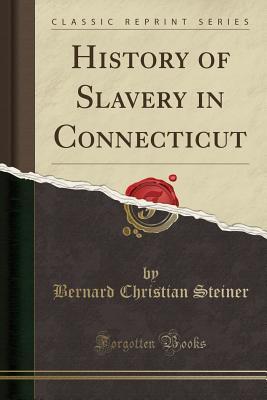Read online History of Slavery in Connecticut (Classic Reprint) - Bernard Christian Steiner | ePub
Related searches:
In new england, connecticut became the second colony after massachusetts to recognize slavery as a legal institution in 1650. Some of the town’s slaves were brought directly from africa or from the west indies. In 1680, thirty slaves were brought from barbados, the history said.
History of slavery in connecticut; by steiner, bernard christian, 1867-1926. Publication date 1893 topics slavery -- connecticut publisher baltimore, the johns.
Connecticut’s first abolitionist society, the connecticut society for the promotion of freedom and the relief of persons unlawfully held in bondage, is formed. 1792 the transportation of slaves to other states for the purpose of selling them is banned.
Excerpt from history of slavery in connecticut few questions have been more interesting to the american people than slavery, and the number of works which have appeared upon the subject has been proportional to the interest aroused.
The 1800 census counted 951 connecticut slaves; the number diminished thereafter to 25 in 1830, but then.
Connecticut blocked the importation of slaves in 1774 and began a gradual emancipation of slaves in 1784 with slavery finally abolished in 1848. Usually, when one thinks about the history of connecticut, slavery is not in the forefront of that thought process.
Benjamin trumbull, the eminent historian, maintained that the first black slave owned in connecticut was louis berbice, killed at the dutch fort 'in hartford by gysbert opdyke in 1639. It is certain that ownership of negroes was common among the leading statemen of our early history.
Jun 19, 2020 at the start of the american revolution, there were ore than 6,400 enslaved people in connecticut, the most of any new england state, according.
Slaves were mentioned in hartford from 1639 and in new haven from 1644. As in the rest of new england, they were few until about 1700. Connecticut citizens did not participate directly in the slave trade in the late 17th century (at least that's what the colonial governor assured the british committee for trade and foreign plantations).
Far from being free of slavery, connecticut’s history is bound up with the oppression of african americans, as well as with their fight for freedom.
Slavery in connecticut dated back to the mid-1600s, and connecticut had more enslaved africans than any other state in new england.
State legislation outlaws the slave trade in connecticut, prohibiting the import of africans and the export of african americans for sale, and requires every slave.
Slavery was a dominant feature of the antebellum south, but it was also pervasive in the pre-civil war north—the new england states of maine, vermont, new hampshire, massachusetts, connecticut.
Jun 15, 2018 we take a look at the history and legacy of slavery right here in connecticut. We talk with one of the authors of complicity: how the north.
Feb 4, 2021 even in its earliest history, connecticut was part of a larger economic system that included slave labor: when the great city of hartford was little.
Lists and discusses fifty cases regarding slaves or slavery that were decided in the connecticut supreme court of errors, 1702-1873. Newtown’s slaves: a case study in early connecticut rural black history. Newtown, ct: newtown historical society, 1994 [csl call number f 104�n78 c78 1994].
Connecticut's growing agricultural industry fostered slavery's expansion.
Far from being free of slavery, connecticut’s history is bound up with the oppression of african americans, as well as with their fight for freedom. La amistad landed in new haven in 1839 when africans being brought from sierra leone to cuba to be sold rebelled against their captors.
Connecticut’s growing agricultural industry fostered slavery’s expansion, and by the time of the american revolution, connecticut had the largest number of slaves in new england.
Sun mon tue wed thu fri sat the farmington historical society.
Connecticut blocked the importation of slaves in 1774, via the passage in the state legislature of the act for prohibiting the importation of indian, negro or molatto slaves and began a gradual emancipation of slaves in 1784, through the passage by the state legislature of the gradual abolition act of that year.
In 1837 when there were approximately 25 slaves in connecticut, a black slave named nancy jackson living in hartford petitioned the state for her freedom, claiming she was “illegally confined” by james bulloch, a slaveowner from georgia who lived approximately half the year in connecticut.
Jul 10, 2020 information gleaned from the wilton historical society and robert russell's book, “wilton, connecticut: three generations of people, places.
In 1774, connecticut had about 5,000 slaves, but almost half became free over the next two decades.

Post Your Comments: